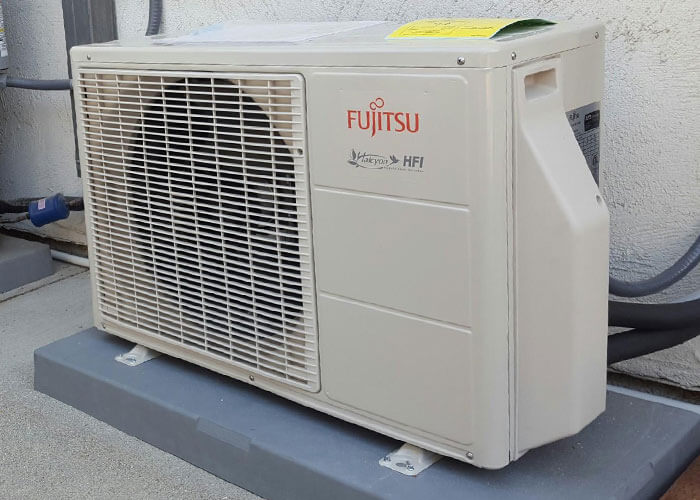How do Ductless Air Conditioners Work?
Ductless air conditioners work in the same way conventional central air conditioners work, but without ducts.
Also known as “mini-splits” or “zoned heating and cooling systems”, ductless HVAC systems operate like a regular AC without ductwork.
On a hot day, they intake the hot, humid air from inside a room, then remove the heat and moisture from the air and dump it outside.
Most mini-splits also operate as a heat pump. This means the outdoor unit extracts heat from the outdoor environment and moves it indoors to raise the temperature of each room.
The main difference between central air conditioning and ductless AC is how they distribute heated/cooled air.
With a ductless HVAC system, cold or conditioned air is distributed directly to each room without ducts. In central air conditioning, cooled air moves through ductwork that distributes into each room via air ducts and vents.
Mini-splits are good additions to houses which are using hydronic heat, radiant heat panels, or space heaters.
Can Mini-Split Air Conditioners Cool an Entire House Sufficiently?
Many homeowners are hesitant to install ductless because they have doubts about the heating and cooling efficiency vs central air.
However, ductless air conditioning is just as effective at cooling and heating as central air. The distinction is ductless AC systems cool each room separately instead of pumping cool air through the entire network of ductwork in your home.
For residential homes, you can usually have up to four indoor air handlers (up to four zones or rooms) for one outside condenser unit.
Components of the Ductless System and Basic Operation
Like a central air conditioning system, the ductless AC system extracts heat from the air inside the house, moves it though a conduit, and expels the heat into the outside environment.
Refrigerant, in the form of a low-pressure liquid, absorbs heat energy from the inside rooms. An internal blower moves cool air through the home. As the heat is absorbed into the refrigerant, it changes state into a low-pressure gas that moves through the suction conduit to the outside compressor. The compressor turns the refrigerant into a high-pressure liquid, and heat is dissipated to the outside air.
There are two components to a ductless HVAC system, the inside unit (evaporator) and outside unit (condenser / compressor).
Indoor Ductless Unit
The indoor unit consists of the evaporator unit. This can be mounted on the wall, or sometimes a slim fit unit on the ceiling.
Thin copper tubing pumps refrigerant into the evaporator from the outside unit. This eliminates the need for ductwork in the walls, attic or basement.
Warm air from inside the house is collected and blown over evaporator coils containing the refrigerant. The heat and humidity is extracted from the air, and the heat energy is transported via copper tubing to the outside unit for dispersal.
Cold air is blown back into the inside room.
Outdoor Ductless Unit
The outdoor unit in a ductless HVAC system contains three parts:
- Compressor
- Condensing coil
- Fan or blower
Compressor
The compressor is the heart of every air conditioning system. In a ductless AC system, the compressor coverts low-pressure gas into high-pressure gas using condensation.
Condensing Coil
The condenser coil turns the hot refrigerant from a high-pressure gas into a high-pressure liquid.
Fan / Blower
The fan in the outside unit disperses heat to the outside environment, as well as drawing air through the condensing coil.
What’s the Difference Between a Mini-Split and Multi-Split?
Mini-Split Air Conditioning Systems
A mini split has a single indoor fan coil and single outdoor condenser. This setup is effective for cooling a singular room without excessive load requirements. If there is enough space to place more than one outdoor condensing unit, multiple units may be used together to provide cooling for an entire building.
In this type of installation, there will be a separate temperature control for each unit. If one unit malfunctions, the other units will continue to operate normally.
Multi-Split Air Conditioning Systems
A multi-split system has one condenser unit that is connected to more than one indoor air handler. A thermostat is connected to each indoor air handler. When the cooling mechanism is engaged, all the indoor units are simultaneously activated. This configuration is cost-effective, but should only be used in buildings where every room has the same cooling requirements.
To achieve zoning using a multi-split ductless air conditioning system, the condensing unit will have to be fixed with individual compressor circuits that are piped to separate air handlers. Multi-zone units can cool or heat several rooms or zones, while a single zone mini-split cools a single room or zone.
Multi-split AC systems allow different rooms to regulate temperature separately using individual thermostats.
How Does a Ductless Heat Pump Work?
Ductless HVAC units that have a heat pump attached work best in moderate, Mediterranean climates like Northern California. In a ductless heat pump, the refrigerant flows in either direction, with the inclusion of a reversing valve. This allows the heat pump to extract ambient heat from the outside environment, and transport that heat inside the house.
Outside of mild climates, an electric heat strip can provide supplemental heat.
Pros and Cons of a Ductless Air Conditioning System
As with a central air conditioning system, there are upsides and downsides to a ductless AC system.
Pros of Mini-Split Systems
Three big pros to ductless AC are energy efficiency, less air leakage, and less noise during operation.
Condensers in central air conditioning systems spend some electricity when they turn on. Ductless systems use inverter-driven compressors, which slow down or speed up depending on the cooling or heating needs of the house.
Mini-split ductless units use about 20% to 30% less energy than central air conditioners for the same cooling power.
Second, there is more cooling efficiency versus a central air conditioner or a window mounted AC unit. In a ducted HVAC system, up to 25% of the cooling efficiency is lost as the air is pushed throughout the network or ducting. In a window mounted AC unit, there is some air loss through the window. With ductless AC, only small incisions need to be created to mount the indoor unit and connect it to the outside condenser. This means more cool air stays in each room.
Lastly, ductless cooling units create less noise than central air conditioning.
Cons of Ductless Air Conditioning
The indoor unit for ductless air conditioning systems is wall mounted. For some homeowners, this aesthetic is undesirable. A ducted HVAC system has air intake registers at various places within the house. However, if you can get past the appearance of a wall mounted unit, ductless AC is just as effective as a ducted central air conditioning unit.
What’s the Ideal Situation for Ductless?
Depending on how your home is built, ductless can be the ideal solution. Mini-splits can provide heating and cooling for the entire house in many cases. In certain scenarios, ductless has a clear advantage over central air.
- Garages, add-on rooms, and man caves
- Cooling specific rooms if you have downsized
- Heating or cooling a specific room where temperature is inconsitent
- Eichler homes in the Bay Area
How Much Does a Ductless HVAC System Cost?
Some considerations for how much a ductless heating and cooling system will cost include the Energy efficiency rating (SEER), the BTU of the system, the square footage of the home being cooled, and the number of “zones” the system requires to cool your home.
If you want to know more about whether a ductless heating and cooling system is the right fit for your home, fill out our free estimate form or call Ventwerx at (408) 422-2987 in San Jose, or (408) 710-9595 in Morgan Hill.



